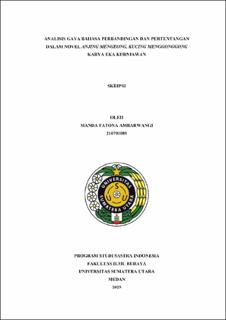| dc.description.abstract | This study aims to describe the role of comparative and contrasting language styles in Eka Kurniawan’s novel Anjing Mengeong, Kucing Menggonggong. The comparative language styles examined include simile, metaphor, personification, allegorie, pleonasm, periphrases, and correction. Meanwhile, the contrasting stylistic devices include hyperbole, irony, litotes, paradox, and sarcasm. The theoretical basis used in this study is stylistics theory, which examines stylistic devices as part of the author’s uniqueness in contructing narratives and characters in literary work. This study uses a qualitative approach with a descriptive method. Data was obtained from primary sources, namely the novel Anjing Mengeong, Kucing Menggonggong by Eka Kurniawan, and analyzed using interactive analysis technique. Data collection techniques were carried out through literature study. From the results of the study, twenty-seven quotations were found to contain similes, twenty-five quotations contained metaphors, thirty-three quotations contained personification, no quotations were found to contain allegories, seven quotations contained pleonasms, four quotations contained periphrases, and five quotations contained corrections. Meanwhile, the style of opposition includes twenty-one quotations containing hyperbole, fifteen quotations containing irony, two quotations containing litotes, one quotations containing paradox, and two quotations containing sarcasm. The results show that comparative language style, especially personification is the most common language style found in Eka Kurniawan’s novel Anjing Mengeong, Kucing Menggonggong. | en_US |


